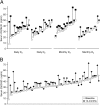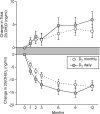Evaluation of ergocalciferol or cholecalciferol dosing, 1,600 IU daily or 50,000 IU monthly in older adults
- PMID: 21289249
- PMCID: PMC3417158
- DOI: 10.1210/jc.2010-0015
Evaluation of ergocalciferol or cholecalciferol dosing, 1,600 IU daily or 50,000 IU monthly in older adults
Abstract
Context: Whether ergocalciferol (D(2)) and cholecalciferol (D(3)) are equally effective to increase and maintain serum 25-hydroxyvitamin D [25(OH)D] concentration is controversial.
Objective: The aim of the study was to evaluate the effect of daily and once monthly dosing of D(2) or D(3) on circulating 25(OH)D and serum and urinary calcium.
Design, setting and participants: In a university clinical research setting, 64 community dwelling adults age 65+ were randomly assigned to receive daily (1,600 IU) or once-monthly (50,000 IU) D(2) or D(3) for 1 yr.
Main outcome measures: Serum 25(OH)D, serum calcium, and 24-h urinary calcium were measured at months 0, 1, 2, 3, 6, 9, and 12. Serum PTH, bone-specific alkaline phosphatase, and N-telopeptide were measured at months 0, 3, 6, and 12.
Results: Serum 25(OH)D was less than 30 ng/ml in 40% of subjects at baseline; after 12 months of vitamin D dosing, levels in 19% of subjects (n = 12, seven receiving daily doses and five monthly doses) remained low, despite compliance of more than 91%. D(2) dosing increased 25(OH)D(2) but produced a decline (P < 0.0001) in 25(OH)D(3). Substantial between-individual variation in 25(OH)D response was observed for both D(2) and D(3). The highest 25(OH)D observed was 72.5 ng/ml. Vitamin D administration did not alter serum calcium, PTH, bone-specific alkaline phosphatase, N-telopeptide, or 24-h urine calcium.
Conclusions: Overall, D(3) is slightly, but significantly, more effective than D(2) to increase serum 25(OH)D. One year of D(2) or D(3) dosing (1,600 IU daily or 50,000 IU monthly) does not produce toxicity, and 25(OH)D levels of less than 30 ng/ml persist in approximately 20% of individuals. Substantial between-individual response to administered vitamin D(2) or D(3) is observed.
Trial registration: ClinicalTrials.gov NCT00692120.
Figures





References
-
- Lips P, Hosking D, Lippuner K, Norquist JM, Wehren L, Maalouf G, Ragi-Eis S, Chandler J. 2006. The prevalence of vitamin D inadequacy amongst women with osteoporosis: an international epidemiological investigation. J Intern Med 260:245–254 - PubMed
-
- Holick MF, Siris ES, Binkley N, Beard MK, Khan A, Katzer JT, Petruschke RA, Chen E, de Papp AE. 2005. Prevalence of vitamin D inadequacy among postmenopausal North American women receiving osteoporosis therapy. J Clin Endocrinol Metab 90:3215–3224 - PubMed
-
- Holick MF. 2007. Vitamin D deficiency. N Engl J Med 357:266–281 - PubMed
-
- Lappe JM, Travers-Gustafson D, Davies KM, Recker RR, Heaney RP. 2007. Vitamin D and calcium supplementation reduces cancer risk: results of a randomized trial. Am J Clin Nutr 85:1586–1591 - PubMed
-
- Holick MF. 2004. Vitamin D: importance in the prevention of cancers, type 1 diabetes, heart disease and osteoporosis. Am J Clin Nutr 79:362–371 - PubMed

